Lecture 1 Financial development and economic growth
- 格式:pptx
- 大小:93.96 KB
- 文档页数:18
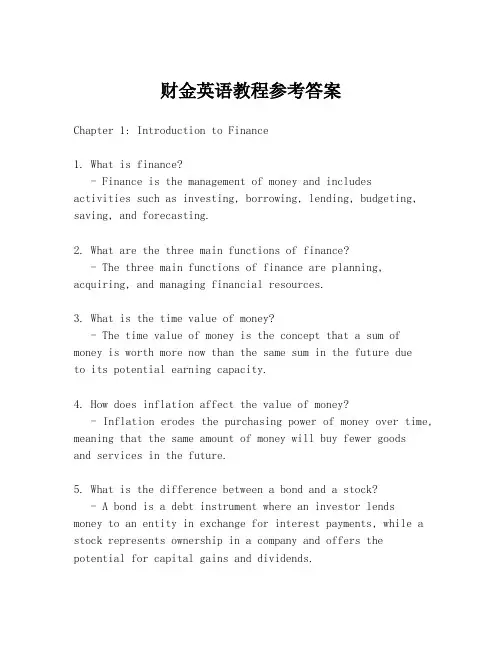
财金英语教程参考答案Chapter 1: Introduction to Finance1. What is finance?- Finance is the management of money and includesactivities such as investing, borrowing, lending, budgeting, saving, and forecasting.2. What are the three main functions of finance?- The three main functions of finance are planning, acquiring, and managing financial resources.3. What is the time value of money?- The time value of money is the concept that a sum of money is worth more now than the same sum in the future dueto its potential earning capacity.4. How does inflation affect the value of money?- Inflation erodes the purchasing power of money over time, meaning that the same amount of money will buy fewer goodsand services in the future.5. What is the difference between a bond and a stock?- A bond is a debt instrument where an investor lends money to an entity in exchange for interest payments, while a stock represents ownership in a company and offers thepotential for capital gains and dividends.Chapter 2: Financial Statements1. What are the four main financial statements?- The four main financial statements are the balance sheet, income statement, cash flow statement, and statement of changes in equity.2. What is the purpose of a balance sheet?- The balance sheet provides a snapshot of a company's financial position at a specific point in time, showing its assets, liabilities, and equity.3. How is net income calculated?- Net income is calculated by subtracting all expensesfrom the total revenue of a company during a specific period.4. What does the cash flow statement show?- The cash flow statement shows the inflow and outflow of cash within a business over a period of time, categorizedinto operating, investing, and financing activities.5. What is the statement of changes in equity?- The statement of changes in equity shows the changes in the equity accounts of a company over a period of time, including retained earnings, capital contributions, and other comprehensive income.Chapter 3: Financial Analysis1. What are the main types of financial analysis?- The main types of financial analysis are ratio analysis,horizontal analysis, vertical analysis, and trend analysis.2. What is the purpose of ratio analysis?- Ratio analysis is used to evaluate a company's financial health by comparing various financial ratios such asliquidity, profitability, and leverage ratios.3. What is horizontal analysis?- Horizontal analysis involves comparing financial statement items over multiple periods to identify trends and changes in performance.4. What is vertical analysis?- Vertical analysis, also known as common-size analysis,is a method of financial statement analysis where each itemis expressed as a percentage of a base figure, typicallytotal assets or total revenue.5. What is trend analysis?- Trend analysis involves examining the historical data of financial metrics over time to predict future trends and performance.Chapter 4: Risk Management1. What is risk management?- Risk management is the process of identifying, assessing, and prioritizing potential risks to an investment or project, and taking steps to mitigate or avoid these risks.2. What are the types of risks in finance?- The types of risks in finance include market risk,credit risk, liquidity risk, operational risk, and legal risk.3. What is diversification?- Diversification is a risk management strategy that involves spreading investments across various financial instruments, industries, or geographic regions to reduce overall risk.4. What is hedging?- Hedging is a risk management technique used to reducethe risk of price fluctuations in an asset by taking an offsetting position in a related security.5. What is the role of insurance in risk management?- Insurance is a risk management tool that providesfinancial protection against potential losses or damages by transferring the risk to an insurance company in exchange for a premium.Chapter 5: Investment Strategies1. What are the different types of investment strategies?- Types of investment strategies include passive investing, active investing, value investing, growth investing, and income investing.2. What is the difference between passive and active investing?- Passive investing involves a "set it and forget it" approach, typically using index funds, while active investingrequires regular buying and selling of individual securities based on market research and analysis.3. What is value investing?- Value investing is an investment strategy that involves buying stocks that are considered undervalued by the market, with the expectation that their true value will eventually be recognized.4. What is growth investing?- Growth investing focuses on companies that are expected to grow at an above-average rate compared to the market, often investing in companies with strong competitive advantages and high growth potential.5. What is income investing?- Income investing is an investment strategy aimed at generating a steady stream of income from investments, typically through dividends or interest payments.Chapter 6: International Finance1. What is international。
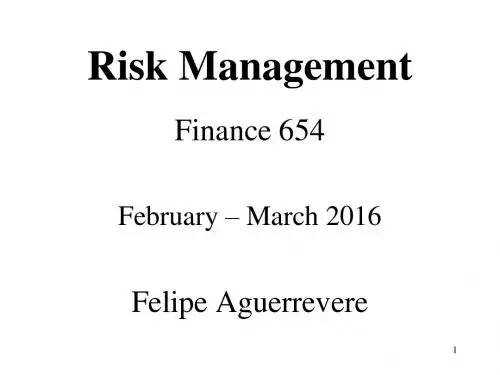

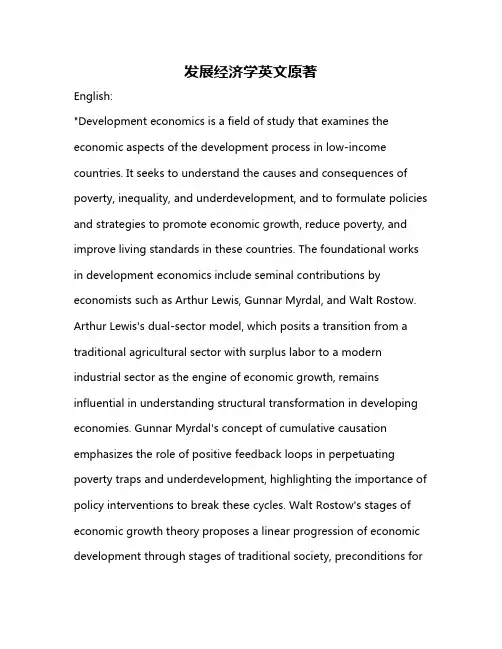
发展经济学英文原著English:"Development economics is a field of study that examines the economic aspects of the development process in low-income countries. It seeks to understand the causes and consequences of poverty, inequality, and underdevelopment, and to formulate policies and strategies to promote economic growth, reduce poverty, and improve living standards in these countries. The foundational works in development economics include seminal contributions by economists such as Arthur Lewis, Gunnar Myrdal, and Walt Rostow. Arthur Lewis's dual-sector model, which posits a transition from a traditional agricultural sector with surplus labor to a modern industrial sector as the engine of economic growth, remains influential in understanding structural transformation in developing economies. Gunnar Myrdal's concept of cumulative causation emphasizes the role of positive feedback loops in perpetuating poverty traps and underdevelopment, highlighting the importance of policy interventions to break these cycles. Walt Rostow's stages of economic growth theory proposes a linear progression of economic development through stages of traditional society, preconditions fortake-off, take-off, drive to maturity, and high mass consumption, providing a framework for understanding the trajectory of economic development. These foundational texts laid the groundwork for subsequent research and policy debates in development economics, which continue to evolve with changing global dynamics and emerging challenges."中文翻译:"发展经济学是研究低收入国家发展过程中的经济方面的一个领域。
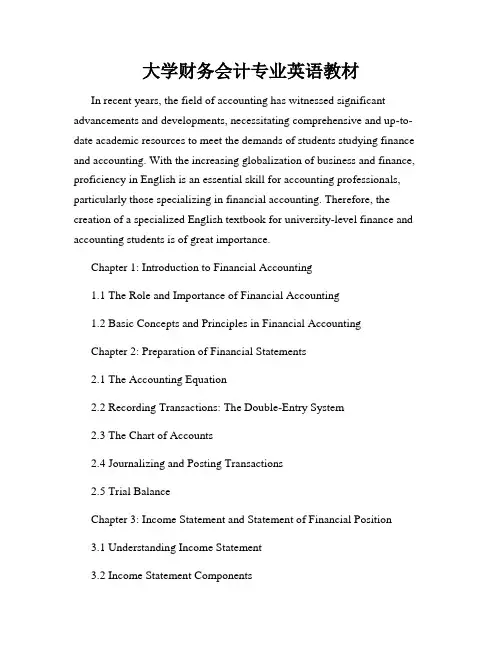
大学财务会计专业英语教材In recent years, the field of accounting has witnessed significant advancements and developments, necessitating comprehensive and up-to-date academic resources to meet the demands of students studying finance and accounting. With the increasing globalization of business and finance, proficiency in English is an essential skill for accounting professionals, particularly those specializing in financial accounting. Therefore, the creation of a specialized English textbook for university-level finance and accounting students is of great importance.Chapter 1: Introduction to Financial Accounting1.1 The Role and Importance of Financial Accounting1.2 Basic Concepts and Principles in Financial AccountingChapter 2: Preparation of Financial Statements2.1 The Accounting Equation2.2 Recording Transactions: The Double-Entry System2.3 The Chart of Accounts2.4 Journalizing and Posting Transactions2.5 Trial BalanceChapter 3: Income Statement and Statement of Financial Position3.1 Understanding Income Statement3.2 Income Statement Components3.3 Statement of Financial Position: Assets, Liabilities, and EquityChapter 4: Revenue Recognition and Measurement4.1 Revenue Recognition Principles4.2 Measurement of Revenue: Sales, Services, and Other IncomeChapter 5: Expense Recognition and Measurement5.1 Expense Recognition Principles5.2 Measurement of Expenses: Cost of Goods Sold, Operating Expenses, and OthersChapter 6: Cash Flow Statements6.1 Importance and Purpose of Cash Flow Statements6.2 Operating, Investing, and Financing Activities6.3 Preparing a Cash Flow StatementChapter 7: Analysis and Interpretation of Financial Statements7.1 Financial Ratios and Metrics7.2 Horizontal and Vertical Analysis7.3 Limitations and Adjustments in Financial StatementsChapter 8: International Financial Reporting Standards (IFRS)8.1 Overview of IFRS8.2 IFRS Framework and Key Concepts8.3 Differences between IFRS and Generally Accepted Accounting Principles (GAAP)Chapter 9: Corporate Financial Reporting9.1 Financial Reporting for Corporations9.2 Disclosure Requirements and Auditors’ Opinions9.3 Regulatory Framework for Corporate Financial ReportingChapter 10: Accounting for Business Combinations10.1 Mergers and Acquisitions10.2 Consolidation Methods and Procedures10.3 Accounting for Non-controlling InterestsChapter 11: Financial Statement Analysis and Valuation11.1 Valuation of Assets and Liabilities11.2 Valuation Techniques: Cost Approach, Market Approach, and Income Approach11.3 Interpreting Financial Statement Analysis for Investment and Decision MakingBy providing a systematic overview of the principles, concepts, and techniques in financial accounting, this specialized English textbook addresses the needs of university students studying finance and accounting. It equips them with the necessary knowledge and skills to understand and apply financial accounting practices in an international context. With itscomprehensive content and clear explanations, this textbook serves as an indispensable resource for students pursuing a career in finance and accounting.。
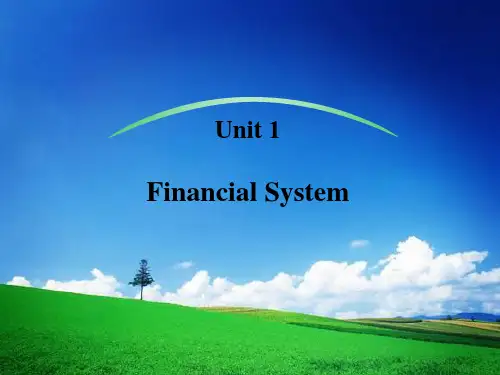
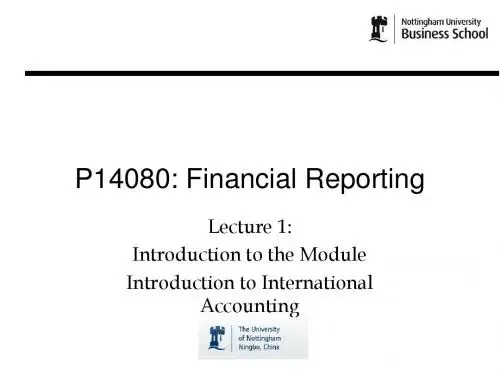

1. Academic: university, college, professor, student, degree, diploma, curriculum, lecture, seminar, laboratory, library, textbook, syllabus, examination, assignment, research, thesis, dissertation, degree program, postgraduate, undergraduate, alumni, faculty, faculty member, dean, tutor, mentor, supervisor, advisor, graduate, postdoc, doctoral, Ph.D., master’s, bachelor’s, associate’s, certificate, honors, grade, GPA, transcript, credit, accreditation, enrollment, course, major, minor, elective, prerequisite, core, concentration, semester, quarter, summer, winter, spring, fall.2. Business: business, corporation,enterprise, industry, market, finance, investment, banking, accounting, management, advertising, consulting, customer, customer service, sales, marketing, strategy, production, supply chain, logistics, distribution, inventory, negotiation, human resources, payroll, labor, employee, job, career, salary, wages, tax, budget, audit, financial analysis, venture capital, merger, acquisition, startup, IPO, dividend, stock, bond, commodity, foreign exchange, venture, portfolio, risk management, venture capital, venture fund, private equity, hedge fund.3. Technology: computer, software, hardware, technology, internet, website, app, mobile, tablet, cloud, network, security, programming, coding, system, algorithm, artificial intelligence, machine learning,data, analytics, automation, robotics, virtual reality, augmented reality, blockchain, cryptocurrency, quantum computing.4. Communication: communication, message, conversation, dialogue, talk, language, writing, reading, listening, speaking, grammar, pronunciation, accent, vocabulary, phrase, idiom, slang, dialect, accent, intonation, tone, register, discourse, rhetoric, media, broadcasting, journalism, presentation, public speaking, speech.5. Education: education, teaching, learning, instruction, school, kindergarten, primary, secondary, high school, college, university, curriculum, pedagogy, lesson, class, student, teacher, professor, tutor, mentor,supervisor, advisor, mentor, mentor-mentee, mentor-protégé, pupil, school board, administrator, parent, guardian, classmate, peer, colleague, student-teacher ratio, student-faculty ratio, student-faculty interaction, student-faculty exchange, student-faculty collaboration.6. Politics: politics, government, policy, law, legislation, regulation, democracy, freedom, liberty, rights, justice, equality, democracy, constitution, nation, state, executive, legislative, judiciary, election, vote, campaign, candidate, party, coalition, diplomat, embassy, ambassador, foreign, international, treaty, alliance, agreement, treaty, protocol, dispute, conflict, war, terrorism, security, defense, military, navy, army, air force, intelligence, espionage, surveillance, investigation.7. Economics: economics, economy, market, finance, investment, banking, stock, bond, commodity, foreign exchange, venture, portfolio, risk management, venture capital, venture fund, private equity, hedge fund, budget, tax, trade, export, import, currency, inflation, deflation, recession, depression, economic growth, economic development, supply, demand, production, consumption, labor, unemployment, poverty, wealth, income, wealth distribution, inequality, competition, monopoly, oligopoly, business cycle.8. Society: society, culture, civilization, community, population, family, gender, race, ethnicity, religion, belief, tradition, custom, value, norm, lifestyle, behavior,attitude, lifestyle, trend, fashion, generation, youth, elderly, generation gap, social class, social status, social mobility, social network, social media, social issue, social problem, social justice, human rights, civil rights, disability rights, animal rights, environmental protection, sustainability, conservation, pollution, climate change.9. Health: health, medicine, doctor, nurse, hospital, clinic, disease, illness, infection, symptom, treatment, surgery, medication, prescription, vaccine, nutrition, diet, exercise, fitness, lifestyle, obesity, mental health, psychology, counseling, therapy, stress, depression, anxiety, addiction, recovery, rehabilitation, wellness, hygiene, safety, prevention, diagnosis, prognosis.10. Science: science, research, experiment, technology, engineering, mathematics, physics, chemistry, biology, astronomy, geology, ecology, environment, natural, climate, evolution, genetics, biochemistry, nanotechnology, quantum mechanics, astrophysics, cosmology, neuroscience, paleontology, archaeology, anthropology, zoology, botany, meteorology, geophysics, oceanography, hydrology.。
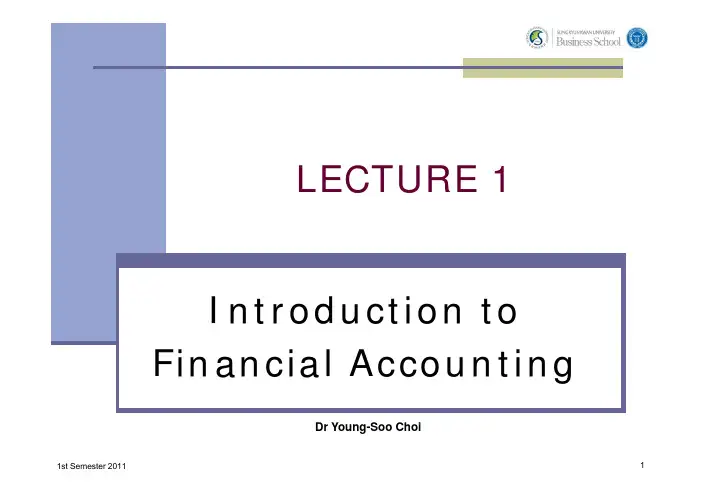


财务管理系课程介绍(中英对照)序号:1课程编码:11001030、11001020课程名称:管理会计Management Accounting学分:3周学时: 3开课系部:财务管理系预修课程:会计学基础、财务会计修读对象:本科生课程简介:本课程是财务管理专业的专业方向课,主要介绍管理会计的基本理论,及如何运用会计及其它经营信息,对企业经济活动进行规划、控制、评价和考核;其主要内容包括:本量利分析、预测分析、投资决策、全面预算、成本控制与标准成本系统、责任会计等。
拟用教材:《管理会计》,毛付根主编,高等教育出版社2000年版参考教材:《管理会计》,余绪缨主编,中国人民大学出版社 1999年版;《管理会计学》(英文版),Ronald W. Hiltion主编,机械工业出版社 2000年版;《管理会计应用与发展的典型案例研究》,潘飞主编,中国财政经济出版社 2002年版Course Code: 11001030、11001020Course Title: Management AccountingDepartment: Financial Management Dept.Credit: 3Periods per week: 3Preparatory Course: Fundamental Accounting, Financial AccountingStudents: UndergraduatesContents:This is a core course for the students whose major is Financial Management. This course introduces the basic theories of management accounting system and itsapplication in the operational activities such as planning, control, evaluation,performance assessing of a business enterprise. The topics covered includecost-volume-profit analysis, business forecasting and its analysis, long-terminvestment decisions making (capital budgeting), master budgeting, cost controland standard costing system, responsibility accounting, etcCourse Book: Mao fugen. Ed. 2000. Managerial Accounting, Higher Education Press Reference Book:Yu Xuying. Ed. 1999. Managerial Accounting, China RenMin University Press;Ronald W. Hiltion. Ed. 2000. Managerial Accounting (English version), ChinaMachine Press; Pan Fei. Ed. 2000. Managerial Accounting Application andDevelopment and Typical Cases Analysis, The Chinese Finance and EconomicsPublishing House.序号: 2课程编码:11002040课程名称:财务管理Financial Management学分: 4周学时:4开课系部:财务管理系预修课程:会计学基础、财务会计修读对象:本科生课程简介:本课程是财务管理专业的专业方向课,主要介绍现代财务管理的基本理论和方法及其具体应用。
Development of financial intermediation andeconomic growth:The Chinese experienceChen HAO ⁎CERDI,Universitéd'Auvergne,65boulevard François-Mitterrand,63000Clermont-Ferrand,FranceReceived 1September 2004;received in revised form 9January 2006;accepted 9January 2006AbstractUsing Chinese provincial data from 1985to 1999and applying recent GMM techniques developed for dynamic panels,this paper examines how the development of financial intermediation influences China's economic growth during the post-1978reform period.Our econometric results show that China's financial intermediation development contributes to its rapid economic growth through two channels:first,the substitution of loans for state budget appropriation and second,the mobilization of household savings.Loan expansion,however,does not contribute to growth since loan distribution by financial intermediaries is inefficient.Deep financial sector reform aimed at correcting this inefficiency is desirable,and is expected to sustain China's economic development in the future.©2006Elsevier Inc.All rights reserved.JEL classification:N15;O16;053Keywords:Financial intermediation;Financial development;Economic growth;China1.IntroductionThe relationship between financial intermediation and economic growth has attracted a lot of attention among economists for a long time,particularly since the emergence of the new theories of endogenous economic growth.Although different economists attach different degrees of importance to financial intermediation,its role in economic growth can be theoretically postulated and has been supported by more and more empirical evidence.Theoretically,financial intermediation,by reducing information and transaction costs,can affect economic growth through two channels:(i)productivity;and (ii)capital formation.With China Economic Review 17(2006)347–362⁎Tel.:+33623848975.E-mail address:achille77fr@yahoo.fr .1043-951X/$-see front matter ©2006Elsevier Inc.All rights reserved.doi:10.1016/j.chieco.2006.01.001348 C.Hao/China Economic Review17(2006)347–362regard to the first channel,it is generally argued that financial intermediaries can promote efficient capital allocation by facilitating risk management,identifying promising projects,monitoring management,and facilitating the exchange of goods and services,which in turn leads to an improvement in total factor productivity(Levine,1997).For example,Greenwood and Jovanovic (1990)show that financial intermediation provides a vehicle for diversifying and sharing risks, inducing a shift in capital allocation towards risky but“high expected return”projects.This shift then spurs productivity improvement and economic growth.Bencivenga and Smith(1991)argue that financial intermediaries,by pooling the idiosyncratic liquidity risks,channel households' financial savings into illiquid but high-return projects and avoid the premature liquidation of profitable investments,which favors the efficient use of capital and promotes economic growth.The impact of financial intermediation on growth through the second channel–capital formation–is ambiguous.Financial intermediation may raise or reduce the savings rate.For example,the development of financial intermediation can raise the returns to savings,which has an ambiguous effect on savings due to the well-known income and substitution effects.However, McKinnon(1973)states that,if all economic units are restricted to self-finance,they need to accumulate funds in preparation for undertaking lumpy investments.Money and physical capital are,therefore,complements rather than substitutes.Thus,financial repression,by imposing interest rate ceilings to keep interest rates at artificially low(even negative)levels,harms domestic savings,capital formation and economic growth,while financial liberalization,which causes interest rates to rise towards market-clearing levels and makes bank deposits more attractive,will raise the demand for money and lead to a higher level of investment and economic growth.Most of the empirical research based on cross-country data suggests a positive relationship between financial intermediation and economic growth.King and Levine(1993)identify a positive correlation between the level of a country's financial intermediation and the growth rate of its real per capita GDP.However,the relevance of the finding is compromised by the problematic issue of causality and the potential bias arising from the joint determination of financial development and growth.Levine(1998,1999)improve upon King and Levine(1993), by using legal factors as instrumental variables for financial intermediation indicators to control for simultaneity bias.They find that the exogenous component of banking development is positively correlated with per capita income growth,productivity improvement and capital accumulation.Furthermore,Levine,Loayza,and Beck(2000)and Beck,Levine,and Loayza (2000)apply recent GMM techniques developed for dynamic panels,and provide more evidence that the development of financial intermediation has a strong and causal effect on economic growth.Since the beginning of economic reform in1978,China's performance in terms of economic growth and financial sector expansion has been impressive.Over the period1978–2001,the Chinese economy saw an annual growth rate of9.4%in real terms,while loans outstanding relative to GDP increased from51.1%to117.1%(China Statistical Yearbook,various years).1It appears that fast economic growth and development of financial intermediation go hand in hand. Is this phenomenon only coincidental,or does it confirm the conclusion of numerous theoretical and empirical research papers that financial development plays an important role in fostering economic growth?Unfortunately,although a lot of studies have been conducted searching for explanations of China's economic miracle,few have considered financial development as a potential determinant of such miraculous growth.Furthermore,most case studies of the finance-1Henceforth,unless otherwise indicated,all data cited are from China Statistical Yearbook(State Statistical Bureau, various years).growth nexus on China use traditional “loan-to-GDP ratio ”-type indicators to measure the development of financial intermediation,and fail to detect a positive relationship between finance and growth.2This paper shows that for the Chinese economy the ratio of loans to GDP reflects only one aspect of the development of financial intermediation,and may be the least significant channel through which the development of financial intermediation affects economic growth.There exist two important channels –the substitution of loans for state budget appropriation and the mobilization of household savings –through which the development of financial intermediation spurs China's economic growth.This paper uses recent Generalized Method of Moment (GMM)estimators in the empirical analysis,and so prevents potential biases induced by simultaneity and unobserved individual-specific effects from compromising the relevance of our findings.The remainder of the paper is organized as follows.Section 2outlines China's development in financial intermediation during the post-1978period.It presents three aspects of this development and analyzes their respective impacts on economic growth.Section 3introduces the economic methodology and our growth regression model,presents the indicators of the development of financial intermediation,and shows the main empirical results.Section 4concludes and draws out some policy implications.2.Financial intermediation in China2.1.The development of financial intermediation in ChinaBefore the reform,China's financial system was characterized by an all-inclusive mono-bank system.The People's Bank of China,the only financial institution,performed the functions of both a central bank and commercial banks.However,under the control of the central government,it played the role of the economy's accounting and settlement center,rather than that of a financial intermediary.Its role was extremely limited on resource allocation.It was only allowed to distribute working capital loans to enterprises,while most fixed asset investments were financed by the state budget.Since the onset of economic reform in 1978,changes have taken hold in China's economy.These changes –particularly the evolution of the national income distribution between government and households –have fostered financial sector development.During the pre-reform period,the government –making use of price policy,state sector labor remuneration policy and the profit transfers regime –controlled an important part of national income,while household income did not exceed the subsistence level.The savings capacity of households was so limited that their share in bank deposits was negligible.Between 1952and 1977,government revenues never fell below 20%of GDP,peaking in 1960at 39.3%of GDP.A major portion of this revenue came from state-owned enterprises (SOEs)profit transfers,averaging 50.5%for this period.For the same period,households'share in total bank deposits never exceeded 17%,with a low point of7.7%in 1962.In 1977,households'total financial savings amounted to only 5.7%of GDP (China Financial Statistics:1952–1991).With so little savings at that time,China's economy didn't need a sophisticated financial system to channel the households'surplus income into productive investments.The economic reform –begun in 1978–has resulted in a material change in the national income distribution through the liberation of prices,the rapid development of non-state 2See Aziz and Duenwald (2002),Boyreau-Debray (2003),Shan,Morris,and Sun (2001),and Shan and Morris (2002).349C.Hao./China Economic Review 17(2006)347–362350 C.Hao/China Economic Review17(2006)347–362enterprises and the granting of greater autonomy to SOEs(Zhang,1999).First,as a result of the liberation of prices,agricultural products'prices increased sharply,raising rural households' earnings,while also raising the input costs of the SOEs-dominated industry,consequently eroded its profit base.Second,the emergence and rapid expansion of the non-state sector intensified competition on the product and factor markets,which broke the SOEs'monopoly,further reduced their profit margins and raised the labor remuneration.Finally,SOEs,having been conferred more and more autonomy,distributed a greater proportion of their revenue to their employees.As a result,government revenue declined from31.2%of GDP in1978to17.1%GDP in2001as its main source,the flow of SOEs profit transfers,gradually diminished.On the other hand,rural and urban households saw their share in national income increasing continuously.This evolution of the national income distribution,on the one hand,limits the government's capacity to finance capital investments through the state budget,3on the other hand,it reinforces the households'savings potential.In2001,households'financial savings added up to7376.2 billion yuan,or76.9%of GDP.There is more and more demand for financial intermediaries to engage in the savings–investment process,channeling households'savings into productive investments in the enterprise sector.Financial intermediation is developing rapidly and plays a critical role in resource allocation.A large number of financial institutions have been established,and the pre-reform mono-bank system has been transformed into a more sophisticated and diversified financial system.Financial intermediaries,especially four state-owned banks,dominate this new system,while the financial market is still at an early stage of development and the scale of direct finance is limited.In2001, the total loans of financial institutions reached11,231.5billion yuan,accounting for117.1%of GDP,while stock market capitalization reached only15.1%of GDP despite impressive growth since1994.4The bond market is essentially reserved for the central government to raise funds. The corporate sector's access to this market is extremely limited.In2001,the total accumulated value of corporate bonds amounted to only100.9billion yuan,accounting for4.0%of the value of total outstanding bonds and1.1%of GDP.Therefore,corporations regard loans as their primary source of external funding;direct finance through bond and stock markets plays only a marginal role.Financial deepening is impressive.Real monetary balances expand at a rate faster than the real economy.Financial depth measured by the ratio of M2to GDP has increased from24.6%in1978 to194.7%in2002,which is among the highest in the world(International Monetary Fund,2003). This striking financial deepening is mainly due to two factors:the monetization of the economy and especially the expansion of households'financial savings.In2001,households'deposits accounted for77.9%of quasi-money and47.2%of M2.Finally,domestic loans,taking the place of state budget appropriations,become the primary external source for financing capital investments.Fig.1shows the changes in financial sources of fixed asset investment.In1981,state budgetary appropriation,as the most important external source,financed28.1%of total fixed asset investment,while the share of domestic loans was only 12.7%.By2001,this situation had completely changed.State budget lost its importance,while loans became the primary means of external finance.Furthermore,some researchers argue that in recent years about half of the funds titled“self fundraising and others”actually comes from loans, 3Moreover,since1985,the central government has been forced to subsidize loss-making SOEs,which limits furthermore its ability to finance capital investments directly.4Stock market capitalization is calculated as the ratio of market value of tradable stocks to GDP.The stocks owned by the state are non-tradable and excluded in the calculation.because some types of loans which are not authorized by the regulations are actually extended to enterprises and enterprises put them in the category “self fundraising and others ”.If this statement is correct,loans actually financed more than one half of the total fixed asset investment in 2001.In conclusion,the development of financial intermediation in China has three main aspects:(i)loan expansion;(ii)mobilization of households'savings;and (iii)substitution of loans for state budget appropriation as the primary source of external funding.2.2.The impact on growth of the development of financial intermediation in ChinaIn this section,we analyze the impact on growth of the three aspects of the development of financial intermediation in China,respectively.China's bank-dominated financial sector is famous for its inefficiency and misallocation of capital.Its distribution of loans,both between the state and the non-state sector and among provinces,is far from rational based on purely economic considerations.The state sector,while contributing less and less to economic growth,continues to absorb a disproportionately large share of bank loans.Under the government's pressure,most household savings are channeled into the inefficient state sector,even into loss-making SOEs by financial intermediaries,particularly the four state-owned banks.As a result of that,the non-state sector,being perceived as the more efficient and dynamic sector,has extremely limited access to debt finance.Furthermore,the distribution of loans among provinces is also seriously affected by the central government's political considerations.The central government regards loans as a means for achieving regional equality.It uses the financial system,especially the state banking sector,to implicitly tax rich provinces and subsidize poor provinces:financial resources are channeled into poor provinces to support their credit expansion (Park &Sehrt,2001).Statistics confirm this argument.Fig.2plots the local state banking sector's loan/deposit ratio against local real per capita GDP.It appears that these two variables are negatively associated with a correlation coefficient of −0.17.This means that provinces with a lower level of economic development receive preferential credit treatment from the central government.Since the actual loan distribution is influenced by political concerns,it may differ from the optimum distribution according to economic fundamentals.Financial intermediaries may have not directed financial resources to their most efficient use.Therefore,the efficiency of loans is questionable.Loan expansion may not be an effective channel through which the development of financial intermediation can promote economica. 19813,8%55,4%28,1%State bugetaryappropriationinvestmentb. 200169,6%4,6%State budgetary appopriation Fig.1.Financial sources of fixed asset investment.Source:State Statistical Bureau (2002).351C.Hao./China Economic Review 17(2006)347–362352 C.Hao/China Economic Review17(2006)347–362Loan/Deposit ratio2.001.751.501.251.000.756.0 6.2 6.4 6.6 6.87.07.27.47.67.88.0 8.2Log(real per capita GDP)Fig.2.Local loan/deposit ratio and local real per capita GDP(1978–1999,average values).Source:Comprehensive Statistical Data and Materials on50Years of New China(1999)and the Research and Statistics Department of People's Bank of China(2000).growth(see the findings of Aziz&Duenwald,2002;Boyreau-Debray,2003;Shan&Morris, 2002;Shan,Morris,&Sun,2001).However,although loan distribution is not totally efficient according to purely commercial considerations,loans are generally considered a more efficient means than state budget appropriation for allocating financial resources.Unlike budget appropriation,loans call for payments of interest and principals.So they help to harden the enterprises'budget constraints,and may promote more efficient use of the provided capital.Moreover,bank employees have more incentives to allocate financial resources toward profitable projects than government bureaucrats, because bank employee compensation is linked to the quality of the lending portfolio.The main consideration of government bureaucrats,however is social stability(Cull&Xu,2003). Empirically,Liu and Li(2001)find a significant relationship between output growth and financial sources of fixed asset investments:compared to state appropriation,domestic loans are used more efficiently and have a larger impact on output growth.The impact of the development of financial intermediation on economic growth may also run through the mobilization of households'financial savings.McKinnon(1973)argues that,when all economic units are confined to self-finance,money balance has to be accumulated before costly and indivisible investment projects can be undertaken,and so money and physical capital are complements.Thus,a rise in interest rate levels stimulates domestic savings and facilitates the process of accumulation and self-finance,which will have a favorable impact on investments and lead to a higher growth rate.This argument seems to be applicable to China.Chinese non-state enterprises and households have actually extremely limited access to bank loans.They rely largely on their own accumulation of funds for financing their investments.So their demand for money and their investments may be positively associated.55In China,the savings deposits of individual enterprises in financial intermediaries are classified into the category “households'savings deposits”.In addition,in China there exist effective informal financing channels that convert household savings into productive investments of non-state enterprises.So the expansion of household savings may increase the availability of financial resources for non-state enterprises and favor their investments.If we review Fig.1,we can find that until now self-finance remains the principal source of investment for the Chinese corporate sector,even when the state sector,the main beneficiary of domestic banking system,is included.For the non-state sector,the category “self fundraising and others ”accounts for 76.4%of total financial resources of fixed asset investments.Even if half of the funds in this category actually come from bank loans,a considerable part of total funds might come from the accumulation of the non-state enterprises and the savings of their employees or other households.Therefore,we conjecture that in China the non-state sector's investments are positively associated with household savings.Since the non-state sector constitutes China's growth engine and its investments are much more efficient than those of the state sector,the expansion of its investment may have a favorable impact on growth performance and productivity improvement.So the mobilization of household savings may constitute an effective channel through which the development of financial intermediation positively affects economic growth.In summary,since the beginning of economic reform,China's financial intermediation took off and became an essential means of allocating financial resources.Financial intermediaries channel more and more household savings into productive investment.However,the distribution of loans is far from socially optimal.But loans are more efficient than state budgetary appropriation for allocating financial resources.The substitution of loans for state budgetary appropriation may improve the efficiency of capital use.So we argue that,in the specific context of the Chinese economy,the development of financial intermediation may favor economic growth through the mobilization of household savings and the substitution of loans for state budget appropriation,but possibly not through loan expansion.3.Financial intermediation and growth:Evidence from China's provincial dataTo empirically assess the impact of the development of financial intermediation on China's economic growth,this study uses provincial data for the following reasons:1.Both the level of economic and financial development vary so significantly among provinces that provincial data may contain interesting information that can be exploited.2.Boyreau-Debray (2003)argues that the degree of inter-provincial capital mobility is low in China,which makes the analysis of local financial intermediation's impact on local economic growth meaningful.3.The time series of many financial variables at the national level are not long enough to allow econometric analysis.The use of provincial data not only increases our choices of financial variables,but also expands the sample size significantly.In the following section,we first introduce the first-differenced GMM estimator developed by Arellano and Bond (1991)and the GMM-System estimator suggested by Arellano and Bover (1995)and Blundell and Bond (1998).Then we construct a set of indicators to measure the development of financial intermediation,describe the data,present our model,and finally show the main results.353C.Hao./China Economic Review 17(2006)347–362354 C.Hao/China Economic Review17(2006)347–3623.1.MethodologyLet us consider the following growth equation:D Y i;t¼aþðb−1ÞY i;t−1þg X i;tþg iþe i;tð1Þwhere Y is the logarithm of real per capita GDP,X is the set of explanatory variables,ηis the timeinvariant individual-specific effect,εis the error term,with the subscripts i and t representing anindividual and time,respectively.Clearly,Eq.(1)can be rewritten as:Y i;t¼aþb Y i;t−1þg X i;tþg iþe i;tð2ÞIn estimating Eq.(2),we are confronted with two main econometric issues.The first oneresults from the introduction of both a lagged dependent variable and an unobserved timeinvariant individual-specific effects in the equation.Hsiao(1986)shows that omitting theindividual fixed effects in a dynamic panel data model will render the ordinary least squares(OLS)levels estimates biased and inconsistent.For example,the likely positive correlationbetween lagged dependent variable Y i,t−1and omitted fixed effectsηi can make the OLS-coefficient estimate bˆbiased upwards.On the other hand,Nickell(1981)shows that the Within groups estimator,an alternative estimation technique which takes into account the fixed effects,gives an estimate of bˆthat is biased downwards in short panels.Thus a consistent and unbiased estimate of bˆis expected to lie in between the OLS levels estimate and the Within groups estimate. The second issue results from the potential endogeneity of explanatory variables.With regard to Eq.(2),a growth regression,the right-hand-side variables are endogenous to some degree.So we must control for the endogeneity of the explanatory variables to avoid potential biases induced by simultaneity.To address these problems,Arellano and Bond(1991)propose the first-differenced GMMestimator.It consists in eliminating the time invariant individual-specific effectsηi by taking thefirst difference of Eq.(2).Doing that we obtainY i;t−Y i;t−1¼bðY i;t−1−Y i;t−2ÞþgðX i;t−X i;t−1Þþðe i;t−e i;t−1Þð3ÞBy construction,(Y i,t−1−Y i,t−2)and(εi,t−εi,t−1)are correlated.OLS estimation of Eq.(3)will not give an unbiased and consistent estimate ofβ.Hence,we must find valid instruments for (Y i,t−1−Y i,t−2).Assuming that(a)the error terms are not serially correlated,E½e i;t e i;s ¼0for i¼1;⋯;N and s p tand that(b)the initial conditions Y i,1are predetermined,E½Y i1e i;t ¼0for i¼1;⋯;N and t z2Arellano and Bond(1991)proposes the following moment restrictionsE½Y i;t−sðe i;t−e i;t−1Þ ¼0for t¼3;⋯;T and s z2Since the values of Y i,t lagged two periods or more are correlated with(Y i,t−1−Y i,t−2),but not with(εi,t−εi,t−1),they are valid instruments for Eq.(3).With regard to the explanatory variables X i ,t ,there are three possible situations:If the explanatory variables X i ,t are strictly exogenous (i.e.,the explanatory variables are assumed to be uncorrelated with all past,present and future values of the error term),then all the past,present and future values of X i ,t are valid instruments for Eq.(3).If the explanatory variables X i ,t are predetermined (i.e.,the explanatory variables are assumed to be correlated with past values of the error term,but uncorrelated with current and future values of the error term),then the values of X i ,t lagged one period or more are valid instruments for Eq.(3).If the explanatory variables X i ,t are endogenous (i.e.,the explanatory variables are assumed to be correlated with past and present values of the error term,but uncorrelated with future values of the error term),then the values of X i ,t lagged two periods or more are valid instruments for Eq.(3).However,Blundell and Bond (1998)argue that when the lagged dependent and the explanatory variables are persistent over time,lagged values of these variables are only weak instruments for the first-differenced equation.And the first-differenced GMM estimator is expected to have a large finite sample bias and poor precision in simulation studies.Blundell and Bond (2000)confirm this statement by showing that in the case of weak instruments,the first-differenced GMM estimator will be biased towards the Within groups estimator.To reduce the potential biases and imprecision,Arellano and Bover (1995)and Blundell and Bond (1998)suggest estimating a system that combines the set of equations in first-differences (Eq.(3))with the additional set of equations in levels (Eq.(2)).For the regression in differences,the instruments are the same as above.For the regression in levels,the instruments are the suitably lagged differences of corresponding variables.Assuming that (a)the differences of the explanatory variables are uncorrelated with the individual-specific effects,E ½D X i ;t g i ¼0for i ¼1;⋯;N and t ¼2;N ;Tand (b)ΔY i 2are uncorrelated with the individual-specific effects,E ½D Y i 2g i ¼0for i ¼1;⋯;N ;then,if the X i ,t are strictly exogenous or predetermined,ΔY i ,t −1and ΔX i ,t are valid instruments for the levels equations;if the X i ,t are endogenous,ΔY i ,t −1and ΔX i ,t −1are valid instruments for the levels equations.The consistency of the GMM-System estimator depends on the validity of the assumption of no serial correlation of the error term,and on the validity of the instruments.This can be tested by two specification tests proposed by Arellano and Bond (1991),Arellano and Bover (1995),and Blundell and Bond (1998).One is a Sargen test of over-identifying restrictions,which can test the overall validity of the instruments.Another is the M 2statistic,which tests the presence of second-order serial correlation in the first-differenced error term.Failure to reject the null hypotheses of both tests provides evidence to suggest that the no serial correlation assumption and the instruments are valid.3.2.Indicators of the development of financial intermediationIn the empirical literature on finance-growth nexus,there are two important issues related to the indicators of the development of financial intermediation:(i)the appropriate measurement 355C.Hao./China Economic Review 17(2006)347–362。
Lecture One 定语从句Other government activities are the responsibilities of the individual states, which have their own constitution and laws.各州都有自己的宪法和法律,承担政府的其他职能。
Within each state are counties, townships, cities and villages, each of which has its own elective government.各州下属辖县,镇,市,村,皆有其民选政府。
一.省略法1.One of the features of London is the number of big stores, most of which are to be found inor near the West End.伦敦一大特色是大商店多,大多数位于西区及其周边地区。
2.Another feature of London’s shopping life is the chain store, in which prices are low and awide variety of goods are offered.伦敦购物生活另一特色是连锁店,里面价格低廉,提供各种商品。
3.Like the press in most other countries, American newspapers range from the sensational,which feature crime, sex and gossip, to the serious, which focus on factual news and the analysis of world events.美国报纸和其他国家一样,既有耸人听闻的小报,报道犯罪,色情和小道消息,也有严肃报刊,聚焦实事新闻,分析国际时事。